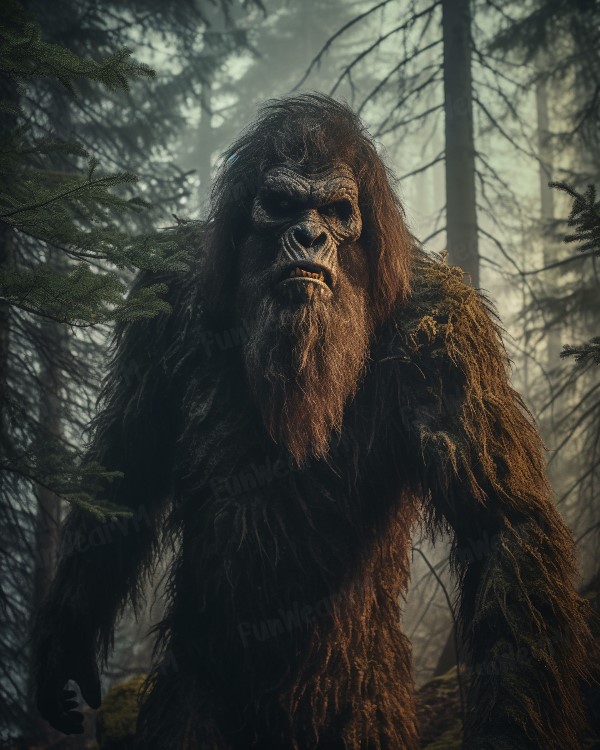
The Skunk Ape is a legendary creature that is said to inhabit the swamps and forests of the southeastern United States, especially in Florida. It is often described as a hairy, bipedal ape-like animal that emits a foul odor, hence the name. Some people believe it is a cousin or a subspecies of Bigfoot, while others think it is a hoax or a misidentification of a known animal.
History of the Skunk Ape
The Skunk Ape has been part of Florida folklore since the European settlers first arrived in the region. Some Native American tribes, such as the Seminole and the Miccosukee, also have stories and legends about a similar creature that they call Esti Capcaki, meaning “tall man” or “hairy man”. The Skunk Ape gained more attention in the 1960s and 1970s, when several sightings and footprints were reported in the media. The term “Skunk Ape” was coined around this time, although other names such as “Swamp Ape” or “Florida Bigfoot” have also been used.
One of the most famous incidents involving the Skunk Ape occurred in 1977, when a woman named Myakka mailed two photographs of an ape-like creature to the Sarasota County Sheriff’s Office. She claimed that the creature had visited her backyard several times and had taken apples from her porch. She described it as being about seven feet tall, with dark hair and an orangutan-like face. She also said it smelled like “a skunk on steroids”. The photographs became known as the Myakka Skunk Ape photos and have been widely circulated and debated ever since.
Another notable figure in the Skunk Ape lore is Dave Shealy, who claims to be the world’s leading expert on the creature. He runs the Skunk Ape Research Headquarters in Ochopee, Florida, where he displays exhibits, sells merchandise and offers tours and expeditions to search for the Skunk Ape. He says he has seen the Skunk Ape four times in his life, starting from when he was 10 years old. He also claims to have captured one of his encounters on video in 2000, which shows a dark figure walking and running across a swamp.
Sightings and Evidence of the Skunk Ape
According to Shealy, an average male Skunk Ape reportedly stands 6-7 feet tall and weighs roughly 450 lbs. Females are considerably smaller, standing only 5-6 feet tall and weighing only up to 250 lbs. The Skunk Ape is covered in mottled reddish-brown hair and has a distinctive odor that some compare to rotten eggs, methane or skunk spray. The Skunk Ape is said to be omnivorous, feeding on fruits, nuts, berries, roots, deer, wild hogs and even alligators. It is also said to be nocturnal, shy and intelligent, avoiding human contact as much as possible.
The main types of evidence that are presented to support the existence of the Skunk Ape are eyewitness accounts, photographs, videos, footprints and hair samples. However, none of these have been conclusively verified by mainstream scientists or wildlife experts. Most eyewitness accounts are vague, inconsistent or unreliable, often coming from tourists or people who are unfamiliar with the local fauna. Photographs and videos are usually blurry, low-quality or inconclusive, often showing nothing more than a dark blob or a person in a costume. Footprints and hair samples are often contaminated, tampered with or misidentified as belonging to other animals such as bears or dogs.
Controversies and Criticisms of the Skunk Ape
The majority of mainstream scientists and wildlife experts dismiss the existence of the Skunk Ape as a product of folklore, misidentification or hoax. They argue that there is no credible physical or biological evidence for such a large primate living in Florida or anywhere else in North America. They also point out that Florida’s climate and habitat are not suitable for supporting a population of ape-like creatures that would require large amounts of food and water. They also question why no Skunk Ape carcasses or bones have ever been found or why no DNA tests have ever confirmed its identity.
Some critics also accuse Shealy and other Skunk Ape enthusiasts of exploiting the legend for financial gain or publicity. They claim that Shealy’s video is a hoax staged by him or his associates using a costume or an actor. They also suggest that Shealy’s research headquarters is nothing more than a tourist trap that sells souvenirs and promotes false information. They also doubt Shealy’s credibility as an expert, noting that he has no formal education or training in zoology or wildlife biology.
Conclusion
The Skunk Ape is one of the most intriguing and controversial cryptids in North America. It has fascinated generations of Floridians and visitors alike with its mysterious appearance and behavior. It has also sparked debates and controversies among believers and skeptics over its existence and nature. Whether it is a real animal, a myth or a hoax, the Skunk Ape remains an enduring part of Florida’s culture and folklore.
References:
- https://en.wikipedia.org/wiki/Skunk_ape
- https://www.smithsonianmag.com/science-nature/trail-floridas-bigfoot-skunk-ape-180949981/
- https://www.floridamemory.com/blog/2014/10/31/the-myakka-skunk-ape/
- https://www.atlasobscura.com/places/skunk-ape-research-headquarters
- https://www.floridaskunkape.com/
- https://www.livescience.com/11331-top-10-beasts-myths.html
- https://www.nationalgeographic.com/news/2016/11/animals-wildlife-mythical-creatures/
- https://www.tampabay.com/features/humaninterest/the-truth-is-out-there-in-ochopee/2225613/
